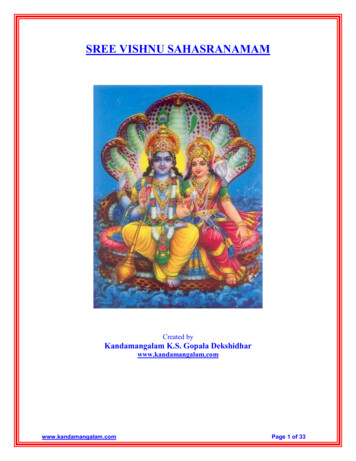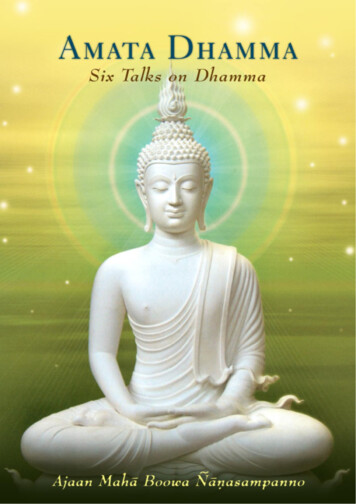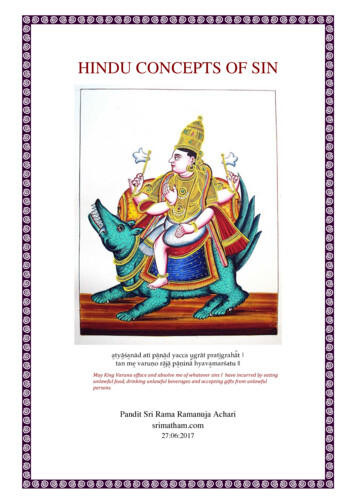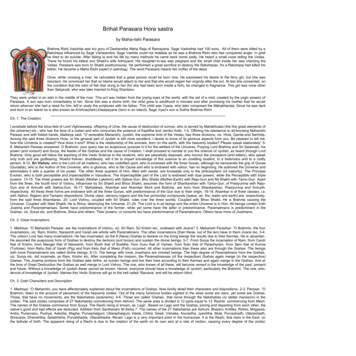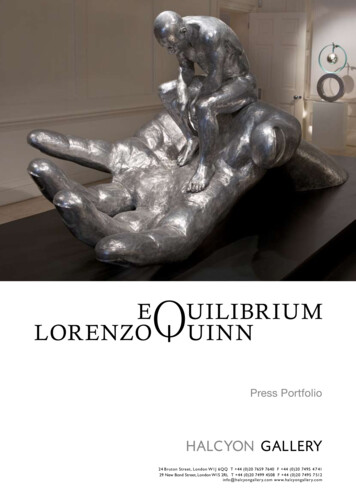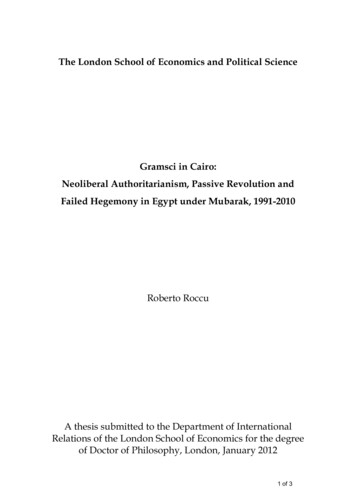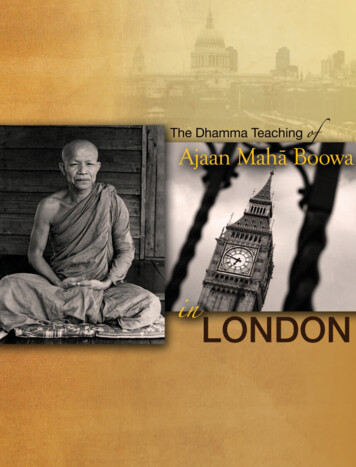
Transcription
inAjaan Maha BoowaLONDON
Ajaan Maha BoowainLONDONThe talks and answers to questions given byVenerable Ajaan Mahā Boowa (Bhikkhu Ñāṇasampanno Mahā Thera)while visiting the Dhammapadipa Vihāra in London, in June of 1974.Translated by:Venerable Ajaan PaññāvaḍḍhoA Forest DhammaPublication
Ajaan Maha Boowa in LONDONA Forest Dhamma Publication“The Gift of Dhamma Excels All Other Gifts”—The Lord BuddhaFOR FREE DISTRIBUTIONAll commercial rights reserved. 2012 Ajaan Mahā Boowa ÑāṇasampannoDhamma should not be sold like goods in the market place.Permission to reproduce this publication in any way forfree distribution, as a gift of Dhamma, is hereby grantedand no further permission need be obtained. Reproductionin any way for commercial gain is strictly prohibited.Author: Ajaan Mahā Boowa ÑāṇasampannoTranslator: Ajaan PaññāvaḍḍhoDesign by: Mae Chee Melita Halim.Forest Dhamma Bookswww.forestdhamma.orgfdbooks@gmail.com
ContentsIntroduction 9First Meeting 13Second Meeting 24Third Meeting 36Fourth Meeting 47Fifth Meeting 58Sixth Meeting 69
Seventh Meeting 77Eight Meeting 89Ninth Meeting 106Tenth Meeting 123Eleventh Meeting 130Twelfth Meeting 146Glossary 161
IntroductionThe Venerable Ajaan Mahā Boowa Ñāṇasampanno accepted an invitation to goto England in June 1974 together with two other Bhikkhus, Venerable Paññāvaḍḍhoand Venerable Abhiceto, originally from the U.K. and Canada respectively. Allthree had the good fortune to be able to stay at the Dhammapadipa Vihāra inHaverstock Hill which was run by the English Sangha Trust. It was there that AjaanMahā Boowa gave the talks recorded in this book, the only exception being thediscussion on 13th June in the morning at Cambridge, when the Bhikkhus went toreceive food at Mr. Benedic Wint’s house.The talks given by Ajaan Mahā Boowa were tape recorded, but the questionsand answers were mostly taken down in shorthand by M.R. Sermsri Kasemsri. It ismainly due to her efforts, not only in taking down the questions and answers, butalso in subsequently transcribing all the talks and her shorthand notes and typingout the manuscript, that the Thai book was produced from which this translationwas made.Translation from Thai into English does not normally present any special problems. But the origin of this book was the spoken word; in addition, the subject
12Ajaan Maha Boowa in Londonmatter is Dhamma, which involves many concepts and technical terms for whichEnglish has a rather poor vocabulary—and often a lack of the necessary fundamental concepts.The teachings of Buddhism may in fact be compared to a technical subject suchas chemistry or electronics in that many technical terms and phrases are necessary. Special concepts and ways of thinking are needed in order to understand andappreciate the reasoning and truth of Buddhism.When it comes to a question of whether to translate a technical word (nearlyalways from the Pāli language into English), the reasoning that has been used is asfollows: If a word in Pāli has a well-known and accurate equivalent in English, thenthe English word is used (e.g., sati—mindfulness; paññā—wisdom). But if there is nowell-known or accurate equivalent, or if the use of an English word leads to moreconfusion or misunderstanding than the original Pāli word, then the Pāli word isused (e.g., samādhi, jhāna).I must apologise to those people who are not familiar with Pāli terms and so findit difficult to read a book like this which has many Pāli terms. But I feel sure thatit is far better for readers to not understand rather than to misunderstand. In anycase, following on this introduction is a short list of those Pāli words that occurfrequently in this book, together with a brief assessment of their meaning, so thatthe reader who is not familiar with those words can have a ready reference. Thereis also a more complete glossary at the end of the book.I should like to thank all those who have helped to produce this book, including M.R. Sermsri Kasemsri for her work on the original book in Thai; Mr. MichaelShameklis for his help in editing the translation of the first thirty or so pages;Bhikkhu Abhijāto for helping to correct many translation mistakes; and toBhikkhu Cittobhāso for typing out the manuscript.Bhikkhu PaññāvaḍḍhoWat Pa Baan Taad, Udorn Thani — Thailand
13IntroductionBrief List of Pāli terms that are usually left untranslated in the text:1. Citta—The heart (in the emotional sense; not the physical heart), the “onewho knows” (but often knows wrongly). The nearest English equivalent isthe word “mind,” except that “mind” is usually understood as being thethinking, reasoning apparatus located in the head, which is too narrow ameaning for the word citta.2. Dhamma—(1) the ultimate meaning is: that basis which is behind all phenomena and is thus the truth. It is unchanging and thus not knowableby that which is impermanent. (2) the Buddha Dhamma, meaning thosepractices and ways of behaviour that conforms to Dhamma and lead onetowards Dhamma.3. Dukkha—discontent, dissatisfaction, suffering, pain, anguish. Dukkha is avery broad and general term covering all those things that are unpleasant,irritating and disturbing.4. Kilesas—Those defiling states arising from greed, hatred and delusionwhich constantly tend to lead us against Dhamma.5. Nibbāna—The state of the citta in which all the kilesas and dukkha have beeneradicated.6. Samādhi—Absorption of the mind when concentrating one-pointedly onan object. It has many levels and few people know more than the initialstages of it.7. Vimutti—Freedom or Liberation, in the sense of freedom from the kilesas,dukkha and attachment to the mundane relative world (sammuti).
14Ajaan Maha Boowa in LondonNote:The letters and numbers in the margins opposite the questions have the followingmeanings. “Q” question, numbered Q1, Q2, etc.; “A” answer. “W” means thata woman asked the question, and “M” means that a man asked the question. Thenumbers W1, W2, etc., and M1, M2, etc., refer to the first, second, or third, etc.,woman or man to ask a question.
First MeetingSunday, June 9th, 1974Questions and AnswersQ1 W1: In establishing mindfulness of breathing, should we fix our attention atthe nose or in the stomach region?A: In establishing mindfulness of breathing, you should fix your sati (mindfulness)on and contemplate the point of contact of the breath.You should not go up and down with it, but keep the citta (mind) fixed on thepoint of contact. If the breath seems to become fainter and fainter, it is nothingto be afraid of or to worry about; the breath has not ceased—it is still there. Thekind of meditation which a person practices depends on the character of each individual practitioner, but the development of the mindfulness of breathing is apractice suitable for the majority of people. The important factor in any method ofmind-development is mindfulness (sati). Forgetting mindfulness means failing inyour task, and you will not get good results. You should therefore take care of yourmindfulness and keep it present when using any method of mind-development.
16Ajaan Maha Boowa in LondonQ2 W1: When sitting in meditation, why is it I get the feeling that there is something pulling my forehead backwards? The muscles in my forehead become tightand I get a headache. Is there any way to remedy this?A: You will have to lessen the intenseness which brings this about. Let the citta beabsorbed only in the breathing. If you are too intense, you will get a headache. Theflow of the citta is very important. You can concentrate strongly or mildly, andwhat you concentrate on will give you results, much or little accordingly.Q3 M1: My being a Buddhist has caused my friends to talk about me. They saythat at one time I used to be a person full of fun and high spirits, and that now I amthe exact opposite. I have lost a lot of friends, and even my wife misunderstandsme and disagrees with me. How can I solve this problem?A: Being a Buddhist does not mean that you must be quiet or look solemn. Iffriends try to get you to go in a way which is unwholesome and you are observingthe moral precepts (sīla), you should not follow them. You might lose your friendsbut you will not lose yourself. If you are satisfied that you have gone the way ofwholesomeness, you should consider the Buddha as an example. He was a princewho had a large retinue and many friends. He renounced the world, gave up thosefriends, and went to dwell alone for many years. After he had attained Enlightenment, he was surrounded by friends and had many disciples who were Arahants(Pure Ones), monks as well as nuns, lay men and lay women, until the number ofBuddhists was more than the population of the world.We all believe in the teachings of the Buddha, which unites the hearts and mindsof all Buddhists. We therefore should not be afraid of having no friends.We should think, first of all, that our friends do not yet understand us, and sothey drift away and no longer associate with us. Our way of practice in the way
17First Meetingof wholesomeness still remains, however. We should see that there are still goodpeople in the world!Good people eventually meet and become friends with other good people, andthese good people will be our friends. If there are no good people in the world,and if there is nobody interested in associating with us, then we should associatewith the Dhamma—with Buddho, Dhammo and Sangho in our hearts, which is better than friends who are not interested in goodness at all. Buddho, Dhammo andSangho are friends which are truly excellent.Ordinarily, those good friends of yours will come back to you. You should therefore rest assured that if your heart is satisfied that you are going in a wholesomedirection, then that is enough. You should not be concerned with or worry aboutothers more than yourself. You should be responsible for yourself in the presentand in the future, for there is nobody but yourself who can raise you up to a higherlevel.Q4 W1: I also have that same experience. My mother knows that I have becomea Buddhist, and she is so upset that she prays to God for my return to Christianityonce again. She is very concerned about me. How should I help her?A: My mother was also worried about my coming to England. She was afraid that Imight die or that something serious might happen. But I saw that there were goodreasons for coming to which she could hardly object, so even though she did notwant me to come, she had to accept those reasons—and I came.Please understand that Buddhism does not teach people to draw away from eachother. Buddhism and Christianity both teach people to be good so that they will behappy and go to heaven. If we compare the city of London to heaven, we could tellpeople that there are many ways to enter the city. When they have chosen a wayand made use of it, all of them will reach London. Whatever religion they have,they should practise it accordingly. Then they will meet in heaven.
18Ajaan Maha Boowa in LondonBuddhism, however, besides having a way to reach heaven, also has the way toreach Nibbāna. If one understands and practises according to the teachings andwants to reach Nibbāna, there are ways for going beyond. Nibbāna means the complete absence of dukkha (unsatisfactoriness, suffering, disease). The Buddha andhis Arahant disciples, being completely free from all defilements (kilesas), have allattained Nibbāna. They therefore should not be worried about anyone who followsthem. You should explain this to your mother so that she will not worry about you,for what Buddhism teaches will be for the stability and prosperity of society. It encourages people to be good, so tell your mother not to worry, that Buddhism is nothell, and that it does not bring disaster or ruin to those who practise its teachings.Q5 W1: My husband is the same. He does not understand what it is that I am doingand he is not at all satisfied with me. It took me twenty years of asking him to letme sit in meditation before he would allow me to do so. I’ve been sitting in meditation for five years now. My husband does not understand about spiritual needs,and so whenever I meet someone whose interest is the same as mine, someone toturn to and be friends with, my husband becomes suspicious.A: When your husband saw that what you were doing was good, that you were notdoing anything which was wrong, he consented of his own accord. This is whatusually happens in the practice of virtue, which is a difficult thing to do. Even inour own heart we hesitate to do good things. When we think of doing somethinggood, another thought arises to prevent us from doing it. Such conflicting thoughtsare bound to struggle with each other before we can turn to the way of virtue.Other people interfering with us is a normal obstacle, but people cannot vie withus in the hindrances we make for ourselves. This is probably the case with everyone. When we want to do something good, which is useful, a state of mind is liableto arise as a hindrance, thus preventing it, so we then waste a lot of time. Beyondthat, it can lead us to do evil things which are really quite harmful.
19First MeetingQ6 W2: If we know that something is not good, we can restrain ourselves, keepingourselves from doing it. Or, if the desire to do something is so strong t hat we willend up doing it anyway, we can go ahead and do it until we get the bad results—then we will dread it. For example, we know that we’ll get a stomachache from eating too many sweets. We can go ahead and eat until we get the stomachache, thenwe will automatically stop. Which one of these two methods is better?A: Knowing what is not good, training the heart and restraining yourself by notallowing yourself to do something bad is better, because no harm is done. If youmake use of the method of giving free rein to the heart, of indulging in your desires until you experience their bad results and then stops by yourself, how doesyou know that you won’t die before you can bring yourself around? And it is justpossible that you will not know the way to get back. This can lead to the ruiningof your life.Q7 M2: I use the method of being aware of the rising and falling of the stomachregion, and it seems as if there is something rubbing my stomach. What is this?A: Are you satisfied with that sensation or not? When you practise meditation andthe citta is quiet and cool, this is good. Then you get the feeling that there is something hard rubbing your stomach. But when the citta is quiet, you are satisfied, thisis what matters.When you get a feeling that there is something rubbing against your stomach,you should understand that this is only a state of mind manifesting itself, thatthere is nothing real or useful to the citta in it. You should then make the citta beaware of the rising and falling. Do not let the mind dwell on the sensation of rubbing. That sensation will subside and pass away by itself.
20Ajaan Maha Boowa in LondonQ8 W3: When I sit in meditation and my mind is close to being one-pointed, closeto being calm, it usually withdraws from this state. It goes in and out, in and out,as if it was about to go through a door but then will not go through. How can I correct this?A: When sitting in meditation, are you not aware of the breath going in and out? Ifyou are and you follow the breath in and out, this will happen. You should fix yourmind only on the place where there is contact with the moving air. You will thenfeel the breath become fainter and fainter until it ceases altogether. The citta willthen enter the state of tranquility (samatha), and it will not go in and out, in andout, as you said.Q9 W1: In meditation practice, is it better to sit alone or to sit in a group? I andfour friends study meditation with the Chao Khun at Wat Buddhapadipa—who hassince disrobed. When I sit by myself, I feel that it is good. But when I sit with myfour friends, I feel anxious and then my practice is not very good. My friends arebeginners. Can we help each other or not?A: You’ve sat in meditation in a group before, how do you feel about it? Are yousatisfied or not? If you feel that you are giving strength to each other, that is good.Even if you yourself feel anxious, yet your friends may gain strength from you tomeditate, that again is good.Bhikkhus usually sit in meditation by themselves except when they go to listento the instruction from their teacher. Apart from that, each does his own practicewithout worrying about anyone else. The citta can become relaxed and peacefulmore quickly than sitting in a group, because there is nothing to disturb it or tomake it anxious.
21First MeetingQ10 W1: When my meditation is good, there seems to be some kind of thread extending about one foot out of my body. Then something seems to come and strikeit. This is very painful.A: How is it now? Is it still there or not?W1: It does not happen anymore now because I felt that pain to be dukkha. I waspatient and countered it, then it went away by itself.A: That feeling is an emotional production—ārammaṇa—of the citta. Sitting in meditation does not cause it to arise. It is the citta itself which causes it to arise. If youbring the citta back to the heart-base in the chest and firmly hold it there, such afeeling will go away by itself.Q11 W1: Sometimes it seems as though my citta goes out to my friend or myfriend’s citta comes to me.A: That is sending the citta outside of oneself which is not good for a person whohas just begun meditation practice. Only those who are skilled at practice can sendtheir citta inside and outside without difficulty because they already know the wayto practice.Ven. Paññāvaḍḍho: When at first we sat down here, Tan Ajaan Mahā Boowa explained that in practising mindfulness of breathing, one should contemplate thein-breath and the out-breath until the breath is very fine. One keeps the citta firmly fixed at the point of contact until there seems to be no more breathing. The cittawill then be peaceful. There is no need to be afraid of the breath stopping, it willstill be there. When the breath has become fine, the citta will feel cool, peaceful.Sometimes, as far as one can tell, breathing seems to have ceased altogether, andthe citta is then very subtle.
22Ajaan Maha Boowa in LondonW1: Please express our appreciation to Ajaan Mahā Boowa for his kindness incoming to talk to us. We are very pleased indeed.Tan Ajaan Mahā Boowa: Buddhism is derived from practice, because the Buddhahimself practised until he himself knew and saw and was able to do it for himself, and only then did he begin to teach others. Buddhists therefore understandthe importance of practising and training themselves according to the teachings.Learning for the purpose of gaining knowledge and understanding, but withoutputting it into regular practice, will not bring results as it ought to. One shouldtherefore study and practice moral precepts (sīla) until it becomes higher morality(adhisīla), study all the different levels of wisdom (paññā) until one reaches the level of higher wisdom (adhipaññā), and study freedom (vimutti). One must then practise until one truly reaches freedom, until one has truly escaped (from saṁsāra).Practise is therefore the most important part of Buddhism.When someone who practises has reached any particular state of development,he will know this for himself. For example, if he practices the development ofmindfulness of breathing, he will know what the state of his breath is, and he willknow to what extent the citta is quiet, still and peaceful. But he must have mindfulness and he must not let the citta wander outside. For someone who is beginningto practise, the most important thing is the citta and mindfulness. The citta willimprove if mindfulness is there to control it, and it will then be peaceful, cheerful,bright, and happiness will come by itself. But if the citta is not controlled by mindfulness, and if it is allowed free rein so that any and all thoughts can insert themselves, the citta will not be peaceful and happiness will not arise. Therefore, themost important rule is to not let the imagination give rise to emotionally chargedthoughts. Train the citta to be truly peaceful, then happiness will follow in thewake of the calm which gradually develops. A high degree of calm means a highdegree of happiness—until it reaches an extraordinary happiness which comesfrom the more subtle levels of concentration.
23First MeetingFor myself, I feel that today is a fortunate occasion in that I have been able tomeet you English Buddhists. I’m sorry that I can’t speak to you in English and mustdepend on Ven. Paññāvaḍḍho to help translate for me. On this auspicious occasion, let us all sit in meditation together, each practising according to his ability.Some of you can perhaps sit for a long time and some of you may tire quickly. Leteach of you decide for how long you can sit before you get bodily discomfort andpain arising so that you gradually withdraw from samādhi. You should, however,try to put up with the pain and discomfort for a while because you really wanthappiness of heart. You have already experienced and know enough about otherkinds of happiness and you have no doubts about them, enough not to be attractedto them.When I was able to sit in meditation for twelve or thirteen hours and it becamepainful, I contemplated the place where the pain was and asked, “What is it that’spainful? A finger? A bone? If they are painful, why are they not painful after oneis dead? Why is it that they are painful now? If the citta is where the pain is, thenif one does not have a body does that mean that the citta dies too, or not?” and soon until I reached the truth (Sacca dhamma). But if you are going to contemplatepainful feeling, you must be brave enough to find the truth. Your desire to knowthe truth must be stronger than the pain and death. Mindfulness and wisdom mustbe continually traversing throughout your mind and body like a wheel which isturning; then you can know.Q12 M2: What is the benefit of sitting in samādhi for a long time?A: Merely sitting for a long time is not good. You must get good results from yoursitting. Then, being engrossed in contemplation, a long time will pass by itself. Thefinal result will be that you become happy and free from pain, and that is good. Ifyou arouse wisdom, when it has arisen the citta will be bright and cheerful, so it
24Ajaan Maha Boowa in Londonwill gain strength. In the future, it will not give up when strong pain arises whilesitting in meditation for a long time.Q13 M2: Should we then simply know that the pain in our bones or fingers isdukkha?A: Only knowing that it is dukkha is not enough. You must contemplate it, examining it with wisdom until you completely understand it. For example, you shouldcontemplate where the exact location of that dukkha is, and why those who havedied do not feel pain. The dead do not know anything: if you take a corpse and burnit, it does not feel the heat. “Knowing that something is painful”—what is that? Isit the citta? When the body dies, does the citta die as well?When you search for and find the basis of truth (Sacca dhamma), you understands clearly because you truly know the heart that is freed from attachment. Ifthe heart is still attached, you do not know truly. The more you want to be rid ofdukkha, the more the dukkha and the origin of dukkha (samudaya) will increase inyour heart. Instead of getting rid of the origin of dukkha, you succeed only in increasing it more than ever.Q14 M2: If we understand natural phenomena clearly and thoroughly, we willthen see dukkha as natural, normal; is that not right?A: Know dukkha, know the nature of the body, know that having a body is dukkha,and know that the body is its own dukkha. Know the nature of citta; and knowingthe citta’s natural state, know that the citta by itself has no dukkha. Why does thecitta have dukkha at all? If you truly knows all this, Sacca dhamma will help to freeyou from dukkha. No amount of dukkha can affect the heart if both these aspectsare truly known in their relationship to each other.
25First MeetingComment: I am very glad to hear that the pain and suffering which we get arisesand passes away, and to learn how to train the citta to get rid of them until freedomis reached.A: In practising Dhamma, each person has various experiences and when we askquestions about these experiences and people hear about each other’s experiences,we gradually widen our understanding. This encourages us and gives us all heart.Ajaan Mahā Boowa then invited those present to sit in meditation. He himselfsat in meditation for a time before returning to his quarters, leaving the lay peoplethere each to sit in meditation as long as they liked.
Second MeetingMonday, June 10th, 1974Ajaan Mahā Boowabeganby asking the following question: “Is there anythingin particular that you would like to discuss today?” When those in the room remained silent, the he spoke as follows:Sitting in meditation while listening to an explanation of Dhamma will greatlyhelp to calm the citta. I shall therefore begin with an explanation of Dhamma, andwhile you are listening please feel free to make use of whatever method of meditation you have practised before. When the citta is calm, you will naturally receivethe taste of Dhamma, each according to his own level of practice.The Buddhist religion which we profess today is the Dhamma to which theBuddha had attained. His name was Samaṇa Gotama. He searched for and practisedmany ways which he saw would bring him to the attainment of the Sacca dhamma(truth) that he was seeking.The word “Dhamma” means the teaching of a Buddha, which is a new Dhammaand a new era that follows upon the Enlightenment of each Buddha and the teaching which he gives to the world. Truly speaking, the “real” Dhamma is always in theworld right from the beginning. But this real, original Dhamma is never touched
27Second Meetingby that which is conventional or mundane (sammuti), even though it is always incontact with the heart. But, although these forms of Dhamma are always presentin the world, we lack the ability to see them.What sort of thing is Dhamma? There is Dhamma as cause and Dhamma as result.Because of this, people are led to think in all sorts of ways that have almost nothingto do with Dhamma or religion.The word “Sāsana” means teaching—the teaching which arose as the result ofthose practices done by the Buddha as he searched for knowledge and truth until he found it. Because he searched in the right way, he attained results whichsatisfied his heart. He then proclaimed this teaching to those people in the worldwho were suited to receive the Sāsana-dhamma—the training and teaching ofBuddhism.Teaching Dhamma to a world full of blindness so that it would come to know thetruth was very difficult for the Buddha—it was no light task. Before he proclaimedhis teaching to the world, men already had various thoughts and ideas, the majority of which were contradictory to the Dhamma. Teaching was therefore verydifficult, but being one of the “Great Teachers of the World” means taking a greatburden on oneself. Very few people desire to become a Buddha, because ordinarymen, unlike Buddhas, do not want to shoulder the great burden of teaching theworld.No one can teach the people of the world as correctly or as accurately as theBuddha did, so he was given the name of “The Highest Teacher in the World”.There is no one comparable to the Buddha because he is superior to all humanbeings. His teaching is fully complete in both cause and effect. Nothing is missingfrom the teachings which he taught to all beings.With regards to Dhamma, he explained wholesome (kusala) and unwholesome(akusala), and neither wholesome nor unwholesome (abyākata) Dhamma. ThisDhamma is svākkhāta-dhamma—Dhamma which is well-explained. The essence of
28Ajaan Maha Boowa in Londonthis Dhamma is in the Eightfold Path, which is the Middle Way. If we were to compare the Middle Way to food, its taste would be delicious, for it would not be toosalty, too tasteless, or too spicy. If we were to compare it to clothes, it would bewell cut and tailored to fit the person wearing it. It would not be like inexpensiveclothes which are mass-produced. The teaching of Dhamma is therefore the Middle Way, which is appropriate in both its causes and its effects from the beginningto the end.Not only is Dhamma the Middle Way, but also the things that we depend on inthe world. If we tried to do everything in the Middle Way, it would be somethingworth seeing, worth admiring, worth living in and making use of. Those men andwomen, monks and novices who practised the Dhamma of the Middle Way wouldbe lovely persons worthy of respect. Both the world and the Dhamma would becool and quiet, so it would be a good world to live in. There would be no complaining that “the world is in trouble”, or that “we are in trouble”, or “he is in trouble”,as is heard at present.Everything is burning with trouble now, so we have practically no world leftto live in. This is because people do not take into consideration the principles ofDhamma which are correct and good. A world divorced from Dhamma—that is,goodness—is therefore a world which is contrary to Dhamma. People are contraryto Dhamma, and this contrariness to Dhamma has the power to produce endlessworry and confusion. As long as we refuse to see our faults and refuse to stop ouropposition to Dhamma, this world will continue to experience dukkha.Magga means the path, which the Buddha declared using the principles of theMiddle Way. It is therefore the only path which always leads straight and steadfastly to vimutti (freedom). It is never outdated and never has to be altered orchanged in any way to keep up with changing situations and changing times. Evenif all things should go on changing until they turn and turn about, the Dhammaof the Middle
The talks and answers to questions given by Venerable Ajaan Mahā Boowa (Bhikkhu Ñāṇasampanno Mahā Thera) while visiting the Dhammapadipa Vihāra in London, in June of 1974. Translated by: Venerable Ajaan
